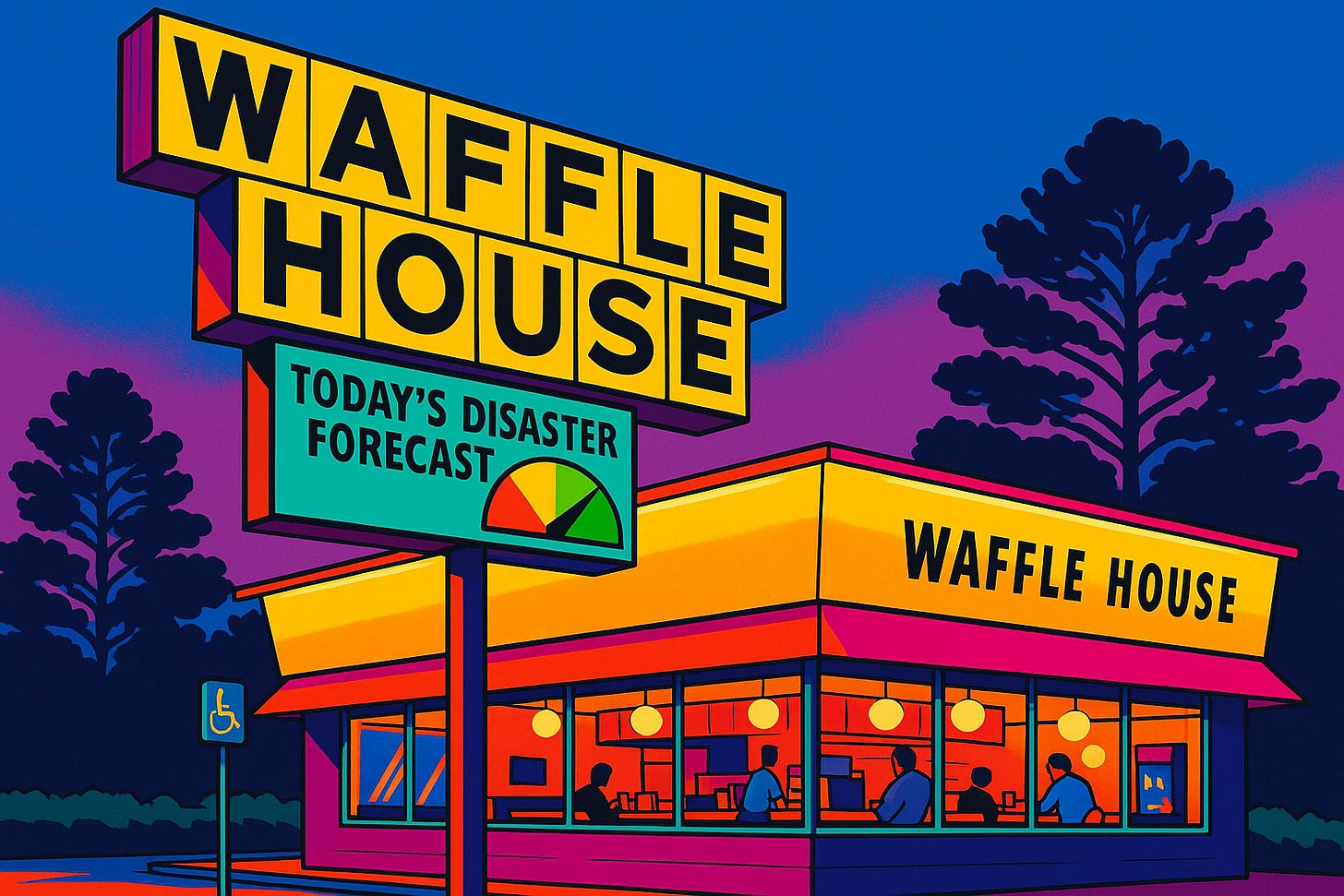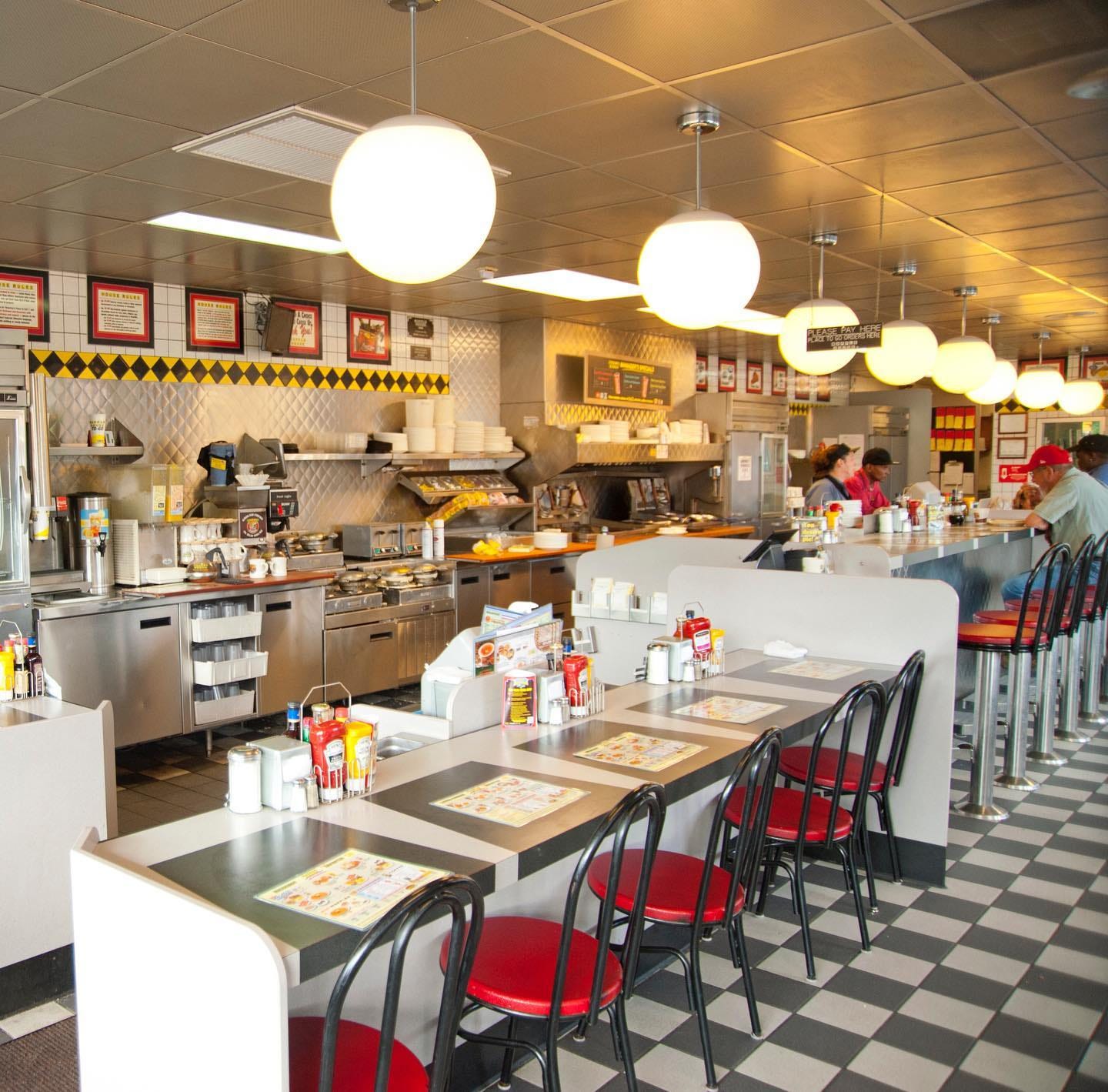Muse #21: Waffle House 911
FEMA is out. Waffles are in. Here's how the next disaster might go.
The Waffle House is considered one of the most reliable indicators of the severity of a natural disaster.
If it’s open as normal (which is 24/7) with a full menu, chill out: the disaster is not disastrous. If the menu is limited, it’s time to ensure there’s gas in the tank and Fido is well-fed. If it’s closed and you’re not yet out of town, start preparing your last waffle and testament.
So reliable is this assessment, there’s a name for it: The Waffle House Index, which FEMA (the Federal Emergency Management Agency) has leveraged for decades in determining an appropriate response to weather events.
But recent cuts have battered FEMA (and the National Weather Service), leading to the Waffle House assuming the role of de facto first-alert system for 1,900 communities across the United States.
Which is why this may be a good time as any to take a deep dive into some of the existential questions of our time, such as: What’s better — pancakes or waffles? And, is the Waffle House up to the task of being an early warning system?
A Waffle House Primer
For those not in the know, the Waffle House is more than just a restaurant for cheap eats … it’s a Southern cultural institution.
Most commonly situated alongside the most trafficked interstate highways, you know what to expect every time you go, whether you order eggs, cheesy grits, or — of course — waffles. There’s nothing flashy, nothing extravagant.
And it’s a no judgment zone; whether you’re in a 3-piece suit or blood-stained camouflage on your way back from hunting feral hogs, no one cares. It’s one of those places that seems to endure no matter what; it has a half-life of forever.
Given this laid-back laissez-faire attitude and seemingly impervious fortitude, while being untested in a leading role, a crisis of epic proportions, like this, can’t be ruled out …
The Brewton Incident
It was a dark and broodily overcast morning on June 2 — the first official day of hurricane season— in Brewton, AL (population: 5,000). On this day, with great fanfare, the local Waffle House turned on the new disaster warning panel on its towering pylon for the first time. The mayor, Yank Lovelace, called it a semolina moment in the town’s storied history.
The panel, nestled beneath the traditional tiled logo, added a new three-color meter to help alert the community of impending disasters. If green all was ok. If yellow: time to think about something other than waffles. If red: run!! It was only after the local meteorologist changed her nightly segment from “AccuWeather Forecast” to “FuccuWeather Report” in light of all the prediction services that were cut that the good people of Brewton urged the Waffle House to step up its game.
That night, the new alert panel shone brightly in the absence of stars or moonlight. And inside the Waffle House, things were bustling when a rogue grill cook decided to change the counter sign that typically read “Steak & Eggs - $11.85” to “Wagyu & Eggs - $14.95.”
The shift supervisor at the time, known among the staff only as Shuga, was incredulous. “What in God’s name is Wagyu, and why is it on the sign?”
“It’s the Black Angus of our time!” says GC.
“Don’t you be bringin’ no street talk into this restaurant, young man.”
“No, it’s not like that Shuga. It’s a fancier name for a slab of beef that tourists think makes it ‘gourmet.’ But here’s the thing: Only way it’s gourmet is, you know, that we can grab an extra four bucks for it. Wagyu, Kobe, Jimmy Dean — nobody really knows the difference. So we just keep servin’ what we’ve been servin’ and bank the difference. The home office’ll take note of how we’re increasing revenues and we’ll all be promoted!”
Shuga, who did everything by the book, was not impressed. “We ain’t doin’ no Wagyu switcheroo. We’re takin’ it down,” she shouted as she reached for the counter sign. But GC would have no part of it and quickly hurled awkwardly across the grill to stop her.
It was at this precise moment that his elbow sent a gallon jug of waffle batter soaring into the air, spattering its contents far and wide, and into not one but two electrical sockets, which promptly shorted the electricity of the entire restaurant and instantly sent the meter on the sign outside to red.
Which didn’t go unnoticed a block away.
Three minutes later, panic ensued throughout the community. Fear raged that a tornado, was resident in those foreboding clouds.
Mayor Lovelace was notified instantly of “Waffle Code Red.”
The town’s volunteer fire department blasted its ear-piercing siren — set to the song “Ain’t no syrup fine enough” by The Squares, a local band signed to Waffle Records, which caused a stampede to the exits at the neighboring Walmart, injuring five and the destruction of an elaborate Cheetos Cheesiest Summer product display.
And the Brewton Best Western loaded up its guests into its shuttle bus and hightailed it to State Highway 41.
That’s when it got even weirder. About 65 miles away at the newly opened Buc-ee’s,
All the while, Shuga and her team back at the Brewton Waffle House were frantically working to replace the blown fuse and restore electricity. Which eventually it did, thus returning the disaster warning sign to green.
Aftermath
Mayor Lovelace had this to say: “This was a humblin’ experience for our town. But we’re all going to be ok. If it teaches us one thing, it’s that — while we may not always agree with how the institutions of our government are run, they are essential to our democratic way of life, safety, and security. So let’s not throw the baby out with the bathwater, ok?
Now, let’s all go and enjoy a plate of that Wagyu & Eggs special at The House!
Author’s note: Brewton is an actual town, Yank Lovelace is its actual mayor, and, yes, Waffle House does have a record label. Everything else in The Incident is fun and fiction.






😆😆😆 This is superb, from "last waffle and testament" to " a “civilian danger warning” by instigating an unusual jerky outage at Buc-ee’s". Informative but hilarious, love it!